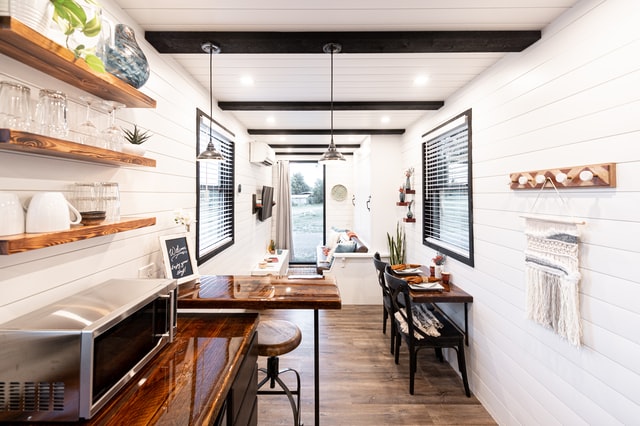Whether you’re a huge movie buff or just a casual fan, having your very own home movie theater can bring the magic of the big screen right to your own home. This awesome room is a great place to sit back and relax or entertain family and friends in a fun way. If you’re thinking of setting up a home theater or remodeling some space available you’ve got at home, it’s important to know how to do it right. From the location and lighting to comfortable seating, you can easily create your very own home movie theater with a bit of planning and the right design. Read on to discover some tips and tricks to help you transform your home into an amazing personal movie theater.
Benefits of a home movie theater
Having a home theater offers numerous benefits, enhancing the overall entertainment experience and adding value to your home. Here are some key advantages of having a home theater:
- Quality time with family: One of the most significant benefits of a home theater is the opportunity to spend quality time with your family and friends. It creates a cozy and immersive environment that promotes bonding, shared experiences and creates lasting memories.
- Enhanced entertainment experience: A home theater provides a superior entertainment experience compared to a traditional TV setup. With high-quality audio and video components, surround sound systems, large screens or projectors, and comfortable seating, you can recreate the atmosphere of a movie theater within the comfort of your own home.
- Increased home value: A well-designed home theater can significantly increase the value of your home. Many homebuyers consider a dedicated theater room or a multimedia entertainment setup as a desirable feature. When it comes time to sell your property, having a home theater can attract potential buyers and differentiate your home from others on the market.
- Personalization: With a home theater, you have full control over the setup and design according to your preferences. You can choose the seating arrangement, lighting, acoustics, decor, and technology components to create a personalized cinematic experience.
- Privacy and control: In a home theater, you have control over the environment, including the volume, seating arrangement, and content selection. You can enjoy movies without distractions, interruptions, or disturbances from other moviegoers. This privacy and control allow for a more immersive and tailored experience.
Overall, a home theater offers the opportunity to create a dedicated entertainment space that enhances family time, provides a superior viewing experience, increases the value of your home, and allows for personalization and customization.
Installing your home theater
Plan ahead
Planning your own home movie theater installation project requires careful consideration of various factors to ensure a successful outcome.
To begin, determine your budget for the home theater installation project. Consider the costs of audio and video equipment, seating, wiring, acoustics, lighting, and any other components you desire. Set a realistic budget that aligns with your financial capabilities and the level of quality you aim to achieve.
Next, it’s essential to talk to your home insurance agent to understand the impact of the home theater installation on your insurance coverage. Inform them about the project and discuss any potential adjustments or additions to your policy to ensure adequate coverage. This step helps protect your investment and provides peace of mind.
Once you have your budget and insurance matters sorted, vet contractors or home theater installation professionals. Seek recommendations from friends, family, or trusted sources, and research reputable contractors in your area. Look for professionals with experience in home theater installations, positive customer reviews, and proper licensing and insurance. Request quotes from multiple contractors and compare them based on factors such as price, expertise, previous work samples, and timelines.
Request detailed proposals from the contractors you are considering. The proposal should outline the scope of work, materials to be used, timeline, payment schedule, and any warranties or guarantees provided. Review the proposals carefully, making sure they align with your expectations and budget.
Last but not least, A good internet connection is crucial for a home theater setup as it unlocks a multitude of features and content options that elevate the overall entertainment experience. With a reliable internet connection, you can access popular streaming services like Netflix, Amazon Prime Video, and Disney+, allowing you to enjoy a vast library of movies, TV shows, and original content directly on your home theater screen.
Additionally, a stable and fast internet connection ensures smooth playback, high-quality video streaming, and minimal buffering, providing uninterrupted viewing pleasure. Furthermore, a good internet connection enables online gaming with low latency and seamless multiplayer experiences. It also facilitates firmware updates for your devices, quick downloads of digital content, music streaming, home automation and control, remote access, and content-sharing capabilities. In summary, a dependable internet connection is a fundamental component of a modern home theater, enriching the entertainment possibilities and ensuring a seamless and immersive cinematic experience.
Choose your location and space
Before you start picking out theater seating, you’ll need to decide which part of your home you want to convert to a home movie theater, location, and space is a must. First, choose a separate, dedicated space where sounds from the big screen won’t affect other members of the household. Ideally, the room should be at least 12 x 12 feet in size or larger.
If you have a spare bedroom on the opposite side of the house, this is a great option. A room over the garage that you aren’t using is a perfect place to design and enjoy a home movie theater. For those who want to go bigger, consider budgeting for a new addition to your home and make it a separate theater space. The room will need to be large enough to accommodate seating and the movie screen itself, and it should also be quiet and dark so nothing disturbs your entertainment experience.
Control ambient light
In order for your movies and sports to look crisp and sharp, it’s important to establish the proper level of ambient lighting. While you’d normally want more natural light in a room, you’ll want less when it comes to a home movie theater. Whether it’s light creeping in from adjacent rooms or sunlight coming in through the windows, it’s crucial to eliminate as much outside ambient light as possible. When the light gets into your theater room, it can make your movies blurry and not as defined. Choose a projector with a high lumens rating to ensure a clear picture if you have ambient lighting that comes in through doors or windows that you can’t control. Ideally, you’ll want to choose a room for your home theater where there are very few (if any) windows, such as a basement or part of a garage. You can buy light-blocking blackout curtains online to keep excess ambient light to a minimum, ensuring your theater stays as dark as possible and also add to the room acoustics.
What you need to know about surround sound
Part of the magic of going to the movies is experiencing incredible sound, so make sure you include a quality surround sound system in this space. Before you start shopping for surround sound systems, make sure the theater room is insulated from outside noise and distractions.
Surround sound typically involves a system with multiple speakers strategically placed around the room to create an immersive audio experience. The most common configuration is a 5.1 setup, consisting of five speakers (front left, front center, front right, rear left, and rear right) and a subwoofer for low-frequency sounds. However, more advanced configurations like 7.1 or even 9.1 setups are also available, offering additional surround and overhead channels for enhanced audio immersion.
Proper speaker placement is essential to achieve optimal movie surround sound. Front speakers should be positioned in front of the viewing area, ideally at ear level, while rear speakers are typically placed behind the seating area. The center channel speaker, responsible for dialogue and on-screen sounds, is typically positioned directly above or below the screen. Subwoofers can be placed anywhere in the room to distribute low-frequency effects evenly.
Consider the acoustics of the room during the installation process. Factors such as room size, shape, furnishings, and wall materials can affect sound quality. Acoustic treatment, including sound-absorbing panels, diffusers, or bass traps, can help minimize echoes, reverberations, and standing waves, ensuring a more accurate and balanced sound reproduction.
Soundproofing
Soundproofing is an important consideration to minimize sound leakage and external noise interference. To enhance the audio experience and prevent sound from disturbing other parts of your home, you can incorporate soundproofing techniques. This can involve using acoustic insulation materials within walls, floors, and ceilings, adding mass-loaded vinyl or soundproof curtains, sealing gaps and cracks, and ensuring proper isolation for speakers and subwoofers.
Cable management
Effective cable management is crucial to maintain a clean and organized appearance for your home theater setup. With multiple audio and video components, speaker wires, HDMI cables, power cords, and other connections, it’s important to plan for cable routing and concealment. Consider using cable raceways, wire channels, or in-wall cable conduits to hide and secure cables along walls or baseboards. Additionally, using cable ties, cable clips, or cable sleeves can help bundle and manage cables behind your AV equipment.
Don’t skimp on seating
Once your new home movie theater is set up, it’s time to think about seating. Of course, you want the seating to be comfortable, but here are some other important features to look for.
Decide on the type of seating that suits your preferences and budget. Home theater seating options range from dedicated recliners and lounge chairs to traditional theater-style seats with cup holders and armrests. Reclining seats provide enhanced comfort and flexibility, allowing you to adjust positions for optimal viewing angles. Consider features like built-in massage or heating elements, USB charging ports, or other customization options based on your personal preferences.
Opt for seating that prioritizes comfort and ergonomics. Look for seats with adequate cushioning, lumbar support, and proper backrest height. Seats with adjustable headrests and footrests can enhance comfort during extended movie-watching sessions. Test out different seating options if possible, and consider materials such as leather or fabric based on your preferences for durability and aesthetic appeal.
Decide on the seating configuration that best fits your needs and space. Popular options include single seats arranged in rows, tiered seating platforms, or curved configurations for better viewing angles. Ensure that the chosen configuration allows for an unobstructed view of the screen from all seats and takes into account any necessary spacing for legroom and walkways.
Set up your screen and projector
No theater is complete without a large screen and a quality projector. Do some research to find the best projectors for home theater settings and look for the features that are most important to you. You’ll want to make sure that your projector is able to produce high-definition content for a crisp, clear picture. Most projectors require an HDMI cable to work correctly. A 4K projector produces the best picture, but they’re also much more expensive than traditional projectors; you could also consider mini projectors. Look for projectors that offer features like focus and brightness level adjustment so you can change the picture as needed. You may need to move the projector around until you find the perfect distance between the projector and the screen. Place the projector on a stable surface where it won’t tilt or move around. A remote control will make it easy to adjust the picture during the movie, so you don’t have to get up or pause the film.
Today’s home theater screens come in a wide range of sizes and quality levels. Choose one that will reduce glare and help to produce a sharp picture. Some screens are stationary, which means they stay in place and don’t roll up once they’re installed. Others include the option to roll up into a contained case so you can use your home theater for other purposes or take the screen with you if you need to. In terms of price, home projectors and screens vary from a few hundred to a few thousand dollars each. Make sure you include both of these crucial components in your budget when you plan your home movie theater setup.
An alternative could be to choose projector paint to paint a wall or space of your preference. This could also help you save money and space.
Decor
When you’re ready to do some finishing touches, you can’t forget paint and décor. Here are some helpful tips and ideas to inspire you to make your home movie theater unique:
- Add molding and trim around the ceiling and on the walls of your theater to give it an authentic movie theater look and feel.
- Choose dark paint to help make the room as dark as possible, such as a matte black or an emerald green.
- Install dimmable lights around the perimeter of the room to recreate that classic movie experience. When the movie starts, slowly dim the lights until they turn off for a fun intro your friends will love.
- Rope lighting and wall sconces are both excellent choices to create soft, warm lighting in a theater space.
- Hang some framed movie posters around the room or display a few fun décor items like vintage refreshment stand signs, movie reels, and popcorn wall painting for a fun theater vibe.
- Install durable carpet that can handle messes and lots of foot traffic. A dark-colored, low-pile carpet is ideal for this room.
- Avoid adding anything that’s too reflective since it can create a glare when the movie is playing. Choose matte paint and frame posters without glass to help you minimize the possibility of annoying glare.
A home movie theater is an awesome way to enjoy your favorite entertainment, from blockbuster films to the big game. Once you decide on the location of your theater, make sure you take steps to reduce outside light and insulate the room from sounds. Choose dark paint colors and soft lighting, and don’t forget to pick out the best projector and screen for a DVD experience. Seating should be roomy and comfortable; you can add your choice of décor to make the room fun. Use these tips to help you recreate the magic of the theater right in your own home.




